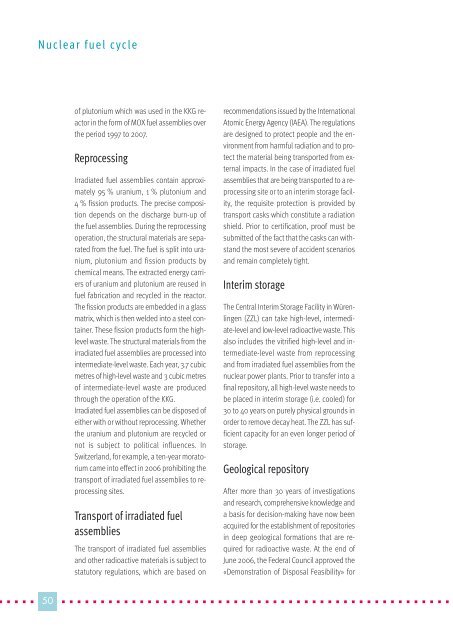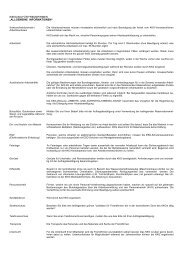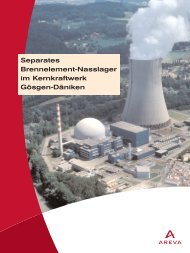Technology and Operation - Kernkraftwerk Gösgen
Technology and Operation - Kernkraftwerk Gösgen
Technology and Operation - Kernkraftwerk Gösgen
Create successful ePaper yourself
Turn your PDF publications into a flip-book with our unique Google optimized e-Paper software.
Nuclear fuel cycle<br />
of plutonium which was used in the KKG reactor<br />
in the form of MOX fuel assemblies over<br />
the period 1997 to 2007.<br />
Reprocessing<br />
Irradiated fuel assemblies contain approximately<br />
95 % uranium, 1 % plutonium <strong>and</strong><br />
4 % fission products. The precise composition<br />
depends on the discharge burn-up of<br />
the fuel assemblies. During the reprocessing<br />
operation, the structural materials are separated<br />
from the fuel. The fuel is split into uranium,<br />
plutonium <strong>and</strong> fission products by<br />
chemical means. The extracted energy carriers<br />
of uranium <strong>and</strong> plutonium are reused in<br />
fuel fabrication <strong>and</strong> recycled in the reactor.<br />
The fission products are embedded in a glass<br />
matrix, which is then welded into a steel container.<br />
These fission products form the highlevel<br />
waste. The structural materials from the<br />
irradiated fuel assemblies are processed into<br />
intermediate-level waste. Each year, 3.7 cubic<br />
metres of high-level waste <strong>and</strong> 3 cubic metres<br />
of intermediate-level waste are produced<br />
through the operation of the KKG.<br />
Irradiated fuel assemblies can be disposed of<br />
either with or without reprocessing. Whether<br />
the uranium <strong>and</strong> plutonium are recycled or<br />
not is subject to political influences. In<br />
Switzerl<strong>and</strong>, for example, a ten-year moratorium<br />
came into effect in 2006 prohibiting the<br />
transport of irradiated fuel assemblies to reprocessing<br />
sites.<br />
Transport of irradiated fuel<br />
assemblies<br />
The transport of irradiated fuel assemblies<br />
<strong>and</strong> other radioactive materials is subject to<br />
statutory regulations, which are based on<br />
recommendations issued by the International<br />
Atomic Energy Agency (IAEA). The regulations<br />
are designed to protect people <strong>and</strong> the environment<br />
from harmful radiation <strong>and</strong> to protect<br />
the material being transported from external<br />
impacts. In the case of irradiated fuel<br />
assemblies that are being transported to a reprocessing<br />
site or to an interim storage facility,<br />
the requisite protection is provided by<br />
transport casks which constitute a radiation<br />
shield. Prior to certification, proof must be<br />
submitted of the fact that the casks can withst<strong>and</strong><br />
the most severe of accident scenarios<br />
<strong>and</strong> remain completely tight.<br />
Interim storage<br />
The Central Interim Storage Facility in Würenlingen<br />
(ZZL) can take high-level, intermediate-level<br />
<strong>and</strong> low-level radioactive waste. This<br />
also includes the vitrified high-level <strong>and</strong> intermediate-level<br />
waste from reprocessing<br />
<strong>and</strong> from irradiated fuel assemblies from the<br />
nuclear power plants. Prior to transfer into a<br />
final repository, all high-level waste needs to<br />
be placed in interim storage (i.e. cooled) for<br />
30 to 40 years on purely physical grounds in<br />
order to remove decay heat. The ZZL has sufficient<br />
capacity for an even longer period of<br />
storage.<br />
Geological repository<br />
After more than 30 years of investigations<br />
<strong>and</strong> research, comprehensive knowledge <strong>and</strong><br />
a basis for decision-making have now been<br />
acquired for the establishment of repositories<br />
in deep geological formations that are required<br />
for radioactive waste. At the end of<br />
June 2006, the Federal Council approved the<br />
«Demonstration of Disposal Feasibility» for<br />
� � � � �50 � � � � � � � � � � � � � � � � � � � � � � � � � � � � � � � � � � � � � � � � � � � � � � � � � � � �




